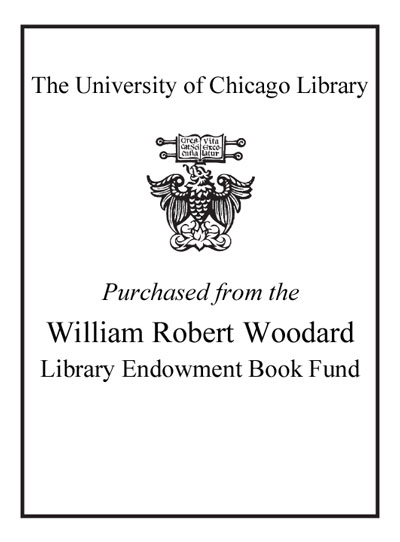Review by Choice Review
Assuming familiarity with the artistic output of the Bauhaus, this study focuses on the "crucible" of post WW I Germany--inflation, unemployment, strikes, political instability--that shaped it. Using East German archives and other sources hitherto untapped, the author traces the almost constant struggle of Walter Gropius to keep his utopian vision of a school financially afloat amidst political and ideological conflicts within the faculty. Politics and morality were entwined in any German aesthetic debate. The swing from a spiritually oriented program at the 1919 founding to the focus on products for industrial design in 1923 is seen as dependent on Gropius's own shifts in mood as well as on local politics. Valuable insights suggest that interpretations by Americans--Alfred Barr, first director of the Museum of Modern Art, Henry Russell Hitchcock, architectural historian, and Philip Johnson, architect--"sanitized" the reputation of the Bauhaus, its people, and products, making it almost more influential in America than in Europe. Hannes Meyer, the Bauhaus's second director, is credited with creating internal stability and developing the workshops more effectively, despite unwise political moves. This study helps to explain why the Bauhaus was nonetheless doomed. Graduate; professional. J. J. Poesch; emeritus, Tulane University
Copyright American Library Association, used with permission.
Review by Publisher's Weekly Review
Like her last book, Architects of Fortune: Mies van der Rohe and the Third Reich, Hochman has produced a meticulously researched, clearly written account of the political forces, economic climates and personalities behind the century's most influential school of art and architecture. In the first three chapters, Hochman details the personal history of Walter Gropius, the Bauhaus founder and first director, giving an empathetic description of his failings, ineptitudes and despairing moods. She then turns to the rise and fall of the Bauhaus, its shift from Weimar to Dessau, where it thrived during the turbulent inter-war period moving to Berlin, where it was closed by the Gestapo. Hochman manages to describe the complex web of politicians, painters, architects and historians involved, from details of their personal lives to the effects of strikes and town protests, with a strong focus that allows the reader to keep pace. The portrait that emerges is a school of conflicting ideals, aesthetic and political, often at the brink of dissolution, run by legendary modernists arguing with each other and falling into deep, dark depressions. For a school whose manifesto spoke of a harmonious co-mingling of the arts to create "the cathedral of the future" aiming for "spiritual revolution" and efficient, clean, machine-inspired aesthetics, the Nietzschean rages behind the walls reveal as much about the turbulent life of the school as the contradictory human motivations behind the ideals. This book is as useful to scholars and connoisseurs as it is accessible to the curious reader. (May) (c) Copyright PWxyz, LLC. All rights reserved
(c) Copyright PWxyz, LLC. All rights reserved
Review by Library Journal Review
Frank Whitford's Bauhaus (1984), a frank, judicious, muscular, and dispassionate chronicling of the art school's fortunes written by a savvy European, remains the basic one-volume history of the Bauhaus. To that account, and to the larger, formidable bibliography on the Bauhaus, Hochman (Architects of Fortune, Fromm Internat., 1990) adds information drawn from archives, diaries, letters, and secondary sources that have been published or become available since 1984. Hochman takes a decidedly biographical approach, also exploring the successive political landscapes of Weimar Germany in which the Bauhaus was born, developed, and died. Ironically, and to the book's detriment, she hardly mentions or seems moved by the legacy of art and design to which the Bauhaus gave birth, a world that is almost coterminous with our own. Still, this is a good complement to Whitford for larger design and architecture collections.Peter S. Kaufman, Boston Architectural Ctr. (c) Copyright 2010. Library Journals LLC, a wholly owned subsidiary of Media Source, Inc. No redistribution permitted.
(c) Copyright Library Journals LLC, a wholly owned subsidiary of Media Source, Inc. No redistribution permitted.
Review by Kirkus Book Review
A concentrated study of the conditions in Weimar Germany that spawned the Bauhaus, its struggles to survive, and its eventual destruction. Critically wounded in WW I, the architect Walter Gropius returned to Berlin ``burning with hope, throttled artistic impulses, and pain,'' and it was in this condition that he opened the doors to an arts and crafts school in the xenophobic city of Weimar. Gropius, writes Hochman (Architects of Fortune: Mies van der Rohe and the Third Reich, not reviewed), had been inspired by the idea of a medieval workers' guild. For the next decade the state-funded school would weather the country's strikes, economic catastrophes, and power swings, but it would never thrive with the ideological and artistic unity that Gropius had hoped to achieve. The Bauhaus failed financially, and eventually Mies van der Rohe took over, moving the institution to Berlin, where he bankrolled it himself until it was raided by the Gestapo in 1933 and closed permanently. Meanwhile, America's infatuation with the Bauhaus ideal had begun in 1926, when Alfred Barr, who would soon head up the Museum of Modern Art, began to write about the new ideas coming from Bauhaus-nurtured architects and designers. But whereas ``the tenets of Gropius' Bauhaus emerged out of the trenches of war, Barr's interpretation of them developed within a milieu of elegant lunches,'' and this, Hochman thinks, was not a good thing. Stripped of its ideological fervor, American Bauhaus ``lacked substance,'' contenting itself with bastardized versions of a style that was never really coherent in the first place. While the author's socio-historical approach fills in a neglected dimension, she pauses too rarely to emphasize what the Bauhaus was producing amid the chaos; the narrative is thus more about the obstacles the Bauhaus faced than what it accomplished. (16 pages b&w illustrations, not seen)
Copyright (c) Kirkus Reviews, used with permission.
Review by Choice Review
Review by Publisher's Weekly Review
Review by Library Journal Review
Review by Kirkus Book Review

